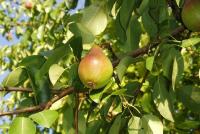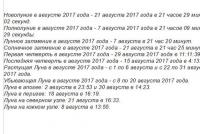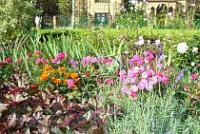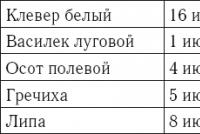How ground cover roses breed. Groundcover Rose Fleurette. Site Selection and Landing
Ground Roses - the perfect decoration for garden designRoses - the most beautiful garden flowers with a delicate scent. The blooming rose garden in the garden is an indicator of the gardener's professionalism, and his pride. Ground cover roses - less than other groups are picky about care. With the right choice varieties with climate in the region, as well as compliance with the conditions of cultivation - they will not cause problems, and will be the perfect decoration of your site.
The best varieties of ground cover roses
Low drooping rose Ice Meillandecor
It belongs to the subgroup - low drooping roses from 50 to 90 cm. The shoots of these roses grow slowly, and have a drooping arched shape. The variety Ice Meillandecor has a bush up to 80 cm high, up to 1 m wide. Green mass is well developed, which allows you to mask the base of the bush.
The flowers are white, gathered in a brush. Winter-resistant variety; practically not subject to diseases. Suitable for middle and southern climatic zones. Requires pruning and bush formation.
Large rose variety - Heidekonigin
It belongs to a subgroup - large varieties from 50 to 100 cm with fast-growing creeping horizontal shoots. Powerful vigorous plant up to 2 meters wide and 80 cm in height.
The flowers are bright pink, terry, 5-6 cm in diameter. Disease resistant frost-resistant variety. It can grow in shade and partial shade and be used as an ampelous plant on retaining walls.
The large drooping rose Fiona
It belongs to a subgroup - large drooping roses, reaches a height of more than 1 m. Shoots have a drooping shape. Large shrub with drooping double pink or coral colored flowers up to 6 cm in diameter.
Due to the lush greenery and large flowers can act as a tapeworm. It is weatherproof, it is practically not exposed to diseases, it is suitable for middle and northern latitudes.
Fru Dagmar Hastrup - roses with upward growing shoots
Delicate non-terry cupped flowers. The bush is large, up to 1.2 m tall. The plant is completely unpretentious, suitable for hedges and urban landscaping.
Withstands polluted and poor soil composition. Does not require shelter for the winter, can grow in any climatic conditions, pruning is not required.
Planting and caring for ground cover roses
Roses are not as picky as many gardeners mistakenly believe. Especially if the organization of the rosary correctly prepare the ground, and choose a place. Care in this case will not cause difficulties, and will be reduced to periodic feeding and pruning, and for some varieties will need shelter for the winter.
Site Selection and Landing
When choosing a place for planting groundcover roses, keep in mind that most varieties are light-requiring, and an open sunny place will suit them. In addition, you need to take into account the size of an adult bush, to which the seedling will grow. It is not recommended to plant more than 5 bushes per 1 square. m beds - for low varieties, and more than 1-2 plants - for large ones.
The planting of roses should be carried out in the spring, at the end of April and the beginning of May. Possible and landing in the fall open ground until the end of September.
Before planting should carefully prepare the soil. It is deeply dug up, choosing roots and weeds. Then pits are prepared for plants 60 cm deep, at the bottom of which organic fertilizers are poured in layers: manure, peat, compost. The bush will feed on this supply of fertilizers for the first two years, therefore the young plant can not be fertilized additionally.
After planting, the soil is mulched, since weeding roses with thorns will become problematic after the bushes grow. In addition, mulch will help protect the soil under the plants from drying out.
Watering ground cover roses
Young bush requires regular watering 2 times a week. Water consumption at the same time 10-15 liters per plant. Watering should be carried out in the morning or in the evening, it is possible in the afternoon in cloudy weather, and only with warm water.
Top Cover Roses
During the growing season, the dressing of roses is carried out in three stages. The first time - in the spring, immediately after the appearance of the leaves on the shoots. Fertilizers must contain nitrogen, phosphorus and potassium. You can use complex fertilizers, such as "Agricola for flowering plants."
The second dressing is carried out before flowering, during the ovary of the buds. Suitable fertilizer, which was used in the first stage.
The third - autumn feeding after flowering. Its purpose is to promote the maturation of the shoots and the preparation of the plant for the winter. Potassium fertilizers are used, for example, potassium monophosphates (1-2 grams per 1 liter of water) or ash (1-2 glasses of ash per bucket of water).
Pruning rose bushes
In the first year after planting, pruning of shoots contributes to tillering of the plant, in other periods it is only sanitary in nature. Damaged, dried branches are removed, the plant form is formed.
The shoots are cut with a sharp shears or a knife at an angle of 45 degrees, at a distance of 0.5-1.0 cm above the living bud. Every five years, the bush should be rejuvenated, shortening all shoots to a height of 25-30 cm. For processing the cuts, they use garden warder, and disinfect the bush by spraying with 1% solution of blue vitriol.
Full information on how to properly cut the roses after flowering, you will find in our article.
Propagation of ground cover roses
The easiest and most effective way of propagation of ground cover roses is division by layering. The long shoot should be bent away from the mother bush and pinned to the ground, or pressed with stones. Experienced Gardeners It is recommended to make shallow holes in those places where the escape is deepened.
In the fall, rooted shoots need to be planted from an adult bush for growing, or immersed in a box with wet sand and stored in the basement for rooting until spring, and then planted in open ground.
Also, any types of roses can be propagated by cuttings. Detailed information about cutting, rooting and preparation of the seedling can be found in our.
Preparing roses for winter
In conditions middle band Russian roses perfectly tolerate the winter under the cap of snow. In regions with a snowless winter, it is recommended to cover the bushes with geotextile or burlap. In the edges with severe frosts over roses, it is desirable to organize a spruce shelter.
Since roses do not shed their leaves for a long time, they can serve as a protection from the cold and a means of snow retention. In the spring, the bushes and the ground beneath them should be cleared of last year's litter, remove damaged and dried branches.
In case of severe frosts, any varieties of roses need protection. Detailed information on how to help roses survive in the winter can be found in our material.
Ground cover roses in the garden: a photo of flower gardens, landscape design
Shoots of some varieties can reach a length of up to 2 meters. A well-grown shrub can cover up to 3 square meters. m flower beds. By combining tall and undersized varieties, you can create carpets and "pillows" from flowering shrubs.
The classic option is a hedge along the paths, a rose garden on the "front flower bed" at the entrance to the plot and a flower garden near the house in the front garden.
An excellent design solution is the design of an arch for lianas - at the foot of plants climbing on a support, ground-covering roses are planted, which cover the base of the scenery.
Also, they are grown to emphasize garden sculptures, fountains, gazebos and wicker fences.
Total
Groundcover roses are great for gardens, designed in any design style, whether country or classic. Pay attention to the choice of varieties for your region, so that there are no problems with frostbite, and provide roses with everything you need - then you will not have any problems with cultivation, and your garden will be transformed decorated with beautiful shrubs.
Of course, all of us gardeners dream of flowers blooming all summer. It is very convenient, especially for busy people who come to the country once a week, and even less. Are there really flowers that bloom all summer hard to say. However, there are plants with a long flowering period and flowers that bloom twice during the summer season. We also recommend that you pay attention to them.
It is worth noting that there are ground cover roses blooming all summer that will surely decorate your country plot.
Groundcover roses grow to a height of about 50 cm, blooms in June, blossoms in blooms. Only one bush of a groundcover rose is able to entice a whole arbor. The blooming of soil-blooming roses is almost infinite - one bud replaces the other.
AT landscape design ground cover roses are used for landscaping slopes.

Types of ground cover roses
- large with shoots that spread (the width of the bush over 1.5 meters in height to 50 cm);
- small shoots that spread (bush width up to 1.5 m, height about 30 cm);
- large with branching shoots (bush width exceeds 1.5 m, height - more than 1 m);
- small with branching shoots (bush width 1.5 cm, height up to 1 m);
- large shrubs that grow straight.
All types of ground cover roses are characterized by:
- The presence of a large shrub with a large number of side shoots, while the width of a rose is several times larger than its height.
- Groundcover roses bloom long and very abundantly.
- Together with buds and inflorescences, many autumn leaves (green mass) grow. Shrubs are very picturesque.
- Accelerated growth of lateral shoots.
- They are not afraid of freezing, the bushes are resistant to diseases.
- Do not require special care, trimming and careful "haircut."

How to grow ground cover roses blooming all summer
It is best to grow a rose grafted on a varietal dogrose, so that there is no wild growth. Groundcover roses grow very hard vegetatively. To dig up a sprig in order for it to sprout and take root is almost impossible.
Roses ground cover planting and care.
Roses bloom all season, and all others also love the sunny place, fertile soil. A pit for planting is dug deep enough - about 50 cm. It is filled with organic matter - compost, humus. Add sand to make the soil lighter. Very good roses respond to ashes. Superphosphate or any other mineral potash - phosphate fertilizer is also added.
In the prepared pit rose and plentifully watered.
When planting ground cover roses:
- in the southern regions, roses are planted in the spring (March 20 - April 20), and in the fall (August 20 - October 20).
- in the northern and middle latitudes of Russia, in the Urals and in Siberia, it is better to plant roses in the spring, because in the fall they may not root enough and freeze in the winter.
Compulsory and dry shelter. It may be dry compost or humus.
In the spring before flowering fertilizing with nitrogenous fertilizers 1 time.
Varieties of ground cover roses blooming all summer.
All ground cover roses are long blooming. We recommend you varieties of roses continuous flowering.
1. Bonika 82 (Bonica 82)
A versatile variety of roses with gently pink flowers, with abundant continuous flowering, endurance and vigor. Resistant to diseases and temperature changes. The flowers grow double in diameter 6 - 8 cm. Most often used as a scrub, for container cultivation, landscape gardening of beds and plots as a ground cover, good for cutting.

2. Dominique Loiseau
Unusually delicate semi-double white Rose. The height of the bush does not exceed 60 cm. The bush is characterized by increased resistance to diseases and pests and at the same time maintains abundant flowering for a long period, can be attributed to the roses of continuous flowering.
Used to create fences and borders with contrasting color inserts, used as a groundcover in the garden.
3. Rose Super Dorothy (Super Dorothy)
A bush with pink flowers with a diameter of 3 cm combined into inflorescences of 7–10 pieces, a bush height 70 cm, lash length 2.5 m, this groundcover rose in diameter, blooming all summer grows with a diameter of up to 2 square meters. m. Used to create flower beds and how climbing rose on a pedestal.

In this video you can learn how to provide proper care for climbing roses.
Deserved recognition and love florist. Ground cover perennial flowers are used to create unique picturesque flower gardens, decorate empty parcels of land, for the decoration of alleys, fences, gazebos and borders. In addition, groundcover roses strengthen the soil in areas of erosion and will not allow the soil to wash out the soil in flower beds on the slope during the rainy season.
If you still have not managed to grow such a moody, but crazy beautiful flowerAs a garden rose, we can offer a win-win - ground cover roses. These cute unpretentious plants have taken best qualities from their tall fellows. How to arrange in your garden a real kingdom of exquisite undersized roses, read on.
To begin with, we suggest that you familiarize yourself with ground cover roses by watching this video plot:
Ground Cover Roses in Garden Design
In the care and planting ground cover roses are almost no different from ordinary roses. But these miniature queens of the garden are able to forgive you a lot more care mistakes than their harsh relatives — ordinary roses.

A hedge of a ground cover rose is a bright lawn dividing strip. Looks delicate and unusual saturated pink rose in the lush green of the lawn grass
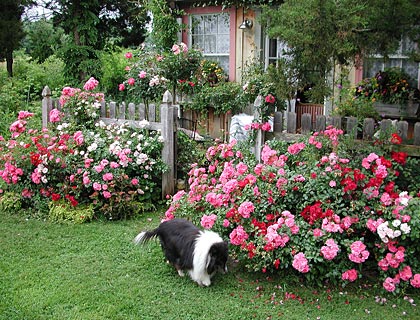
Rich flower beds of different varieties of ground cover roses - the best decoration for the front garden of a country house or cottage
For the effective cultivation of short growing roses you will need some simple, but important rules:
Rule # 1 - The undersized rose is planted with a thickness of 3-5 bushes per square meter. This groundcover culture is growing rapidly, forming a blooming veil on the flowerbed.
Rule # 2 - you need to plant roses in sunny beds, but you should water them early in the morning, or after dark. If the water on the leaves and petals is warmed by sunlight, your rose will burn and lose its decorative effect.
Rule # 3 - planting multicolored varieties of dwarf roses together is not only possible, but also very preferable. The fact that roses of different types clog each other is simply a myth of inexperienced flower growers. A brightly colored carpet of white, red, and yellow ground cover roses.

Bright red roses are a stylish design for white wooden arches or gazebos. The rich colors of these roses will decorate any front garden
Rule # 4 - At the beginning of cultivation, the soil under the roses should be well mulched and free from weeds. This can be done with needles, sawdust or small gravel. Over time, the roses will grow and will push out all weeds.
Rule # 5 - to grow the most beautiful roses will help you the right food. In the spring, for obtaining saturated green foliage and healthy buds, roses need nitrogen fertilization. When the flowering period began, mineral fertilizers will become irreplaceable. By the cold, the roses are gradually stopped to feed, so that the flowers can go to rest until the warm season of the next season.
Rule # 6 - roses winter well in open soils. However, it is worthwhile in the harsh climate conditions to take care of the shelter of these flowers in the winter. You can use organic insulation - dry leaves or needles, or you can cover the roses with a special cloth, or put them on the ground.
Rule # 7 - with the advent of heat, roses open, clean from rotten shoots and feed a week or two after an early awakening.

The sloping beds of a large garden with stone curbs can be effectively decorated with different varieties of ground cover roses.
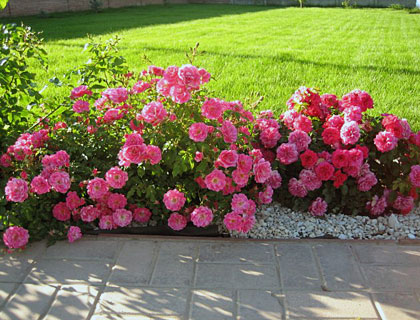
A border of scarlet low-growing roses is the best solution for bright decoration of green lawns. This rose looks great along granite paths or paths from garden tiles.
What pink varieties are known as the best and most successful in growing? Let's discuss this moment together.
The best varieties of ground cover roses
Grade # 1 - Red Blanket
The bright fragrant low rose of Red Blanket with large red flowers really reminds an expensive Persian carpet. The long shoots of this flower lean low to the ground, without touching it. Rose can decorate any place in the garden and courtyard, forming lush abundant blooming hills.

The lush rose buds of the red blanket can be a bright pearl of any rose garden. This variety will provide long and active flowering.
Grade # 2 - The Fairy
This variety will please the owners with a long fragrance of thick coral roses. The Fairy is planted on the verandas, the foregrounds of pink flower beds and flower beds, and at small fences.
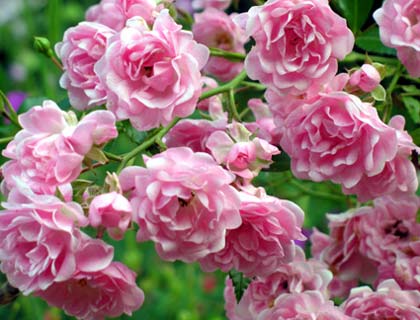
The fine and fresh aroma of the rose The Fairy is especially vivid in the early morning. This was the reason for the popularity of this wonderful variety for planting on verandas and gazebos.

The border of soft pink The Fairy will decorate even the most inconspicuous lawn. The evening romance of walks is provided if along garden paths this rose is fragrant
Grade # 3 - Lovely Meilland
Rose Lovely Meilland will give you buds of a delicate pink color with small petals. This variety is very beautiful, it is often used for planting on the most prominent places of the flower garden to create a romantic garden style.
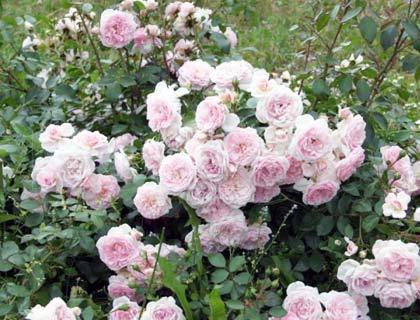
Groundcover rose Lovely meilland grows in a flowerbed in the form of small lush bouquets. Her delicate flowering is the best gift for caring flower growers.
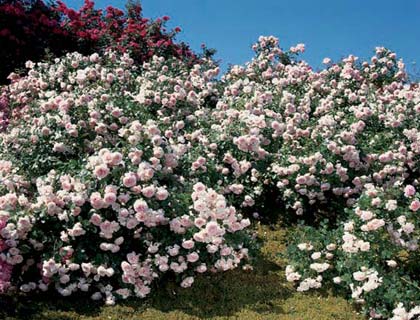
Flowerbeds with delicate rose Lovely meilland look like a miniature romantic garden for fairytale characters. This unique variety is beautiful in both the developed and the wild-growing version.
Grade # 4 - Avon
Pink buds and white flowers of this rose create an interesting contrast on the flowerbed. A flower on a thin stalk looks so fragile. However, the delicate-looking petals of this rose tightly frame the yellow center. All summer, and even with the onset of autumn coolness, you can breathe in the refreshing aroma of Avon rose.
Grade # 5 - Patte de Velours

Rose Patte de Velours has no thorns. The long branches of this two-colored variety gently lean to the ground, giving the flower garden a natural, natural look.
This groundcover rose has an unusual shape and color of buds. The flowers are small, pink-white inside, have a red border on each petal. But Patte de Velours is unique not only in coloring. Her long, curly stems do not have thorns at all, so her second name is a baby rose.

The unusual color of the Patte de Velours rose makes it look like a flower from expensive pink lace. Planted along the stone paths, this rose will give a bright and unusual look to the garden landscape.
Bright design solutions with undersized roses in the garden
And now the time has come to discuss the most interesting. Professionals will tell you how best to use ground cover roses in garden design.
Option # 1 - languid arbor
Ah, France, the time of Angelica and court balls of the Louvre! Such thoughts can visit your head in the evening gazebo, entwined with white or pink ground cover roses. Lovers of roses in the garden must have such an arbor, or they have long dreamed of creating it. You do not need to dream for a long time, because this is a workable case.
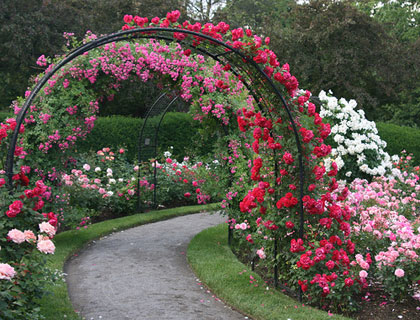
Arches of multicolored lash-up roses are a stylish design solution for a summer cottage. Romance and delicate fragrance - what you will feel while walking in such a garden
Rose bushes around the gazebo outside so that there is a meter between the roses. Plysis these flowers can be on the fishing line or ordinary rope. In order for the rose to completely wrap around the gazebo, it will take a year and a half. It is better to choose the variety with long curly stems and dense flowering. A rose like Ideal, Little Darling, Scarlett Jam and others will do.
Option # 2 - Pink Cascade
Very nice look varieties of groundcover roses planted steps. To do this, make a multi-level flower bed and landed at each step. different varieties roses. Absolutely any varieties are suitable for such a design idea. The effect of a uniform cascade can be achieved by cutting roses as they grow.

Fabulous looking scarlet weaving ground-covering rose near a small artificial stream surrounded by coniferous trees
Option # 3 - a fragrant veranda
You can feel yourself as a real English lord or lady on a summer morning veranda framed by roses. After all, the most pleasant morning start is early tea in a pink flavor. You can decorate the veranda of the house with roses in different ways: pots with roses, long flower beds, pots or wicker roses from the street. For pots on the porch or balcony, you need to choose a miniature unpretentious varieties soil-covering roses: Mariatheresia, Apricot Clementine and other beautiful species.
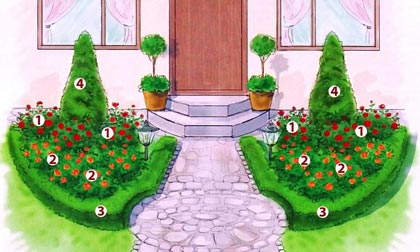
A great decor for the porch - beds of ground cover roses. 1 - Red blanket rose, 2 - Patte de Velours, 3 - zhivuchki border, 4 - dwarf thuja
Option # 4 - gentle borders
Original and gently look borders of roses along the paths or lawns. A green lawn can be contrasted with a red, pink or white border from these extraordinary plants. Such a lively pink hedge can advantageously hide defects of the fence, walls, or simply revive the boring landscape near the house. Beside the pink border, be sure to build a small white bench on which to relax with your favorite book you will be working in the garden, or just dozing in the exquisite aroma of roses.
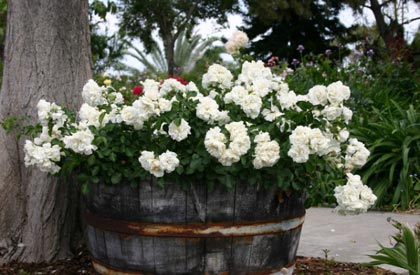
A small white groundcover rose will decorate any old container, such as an old wooden trough.
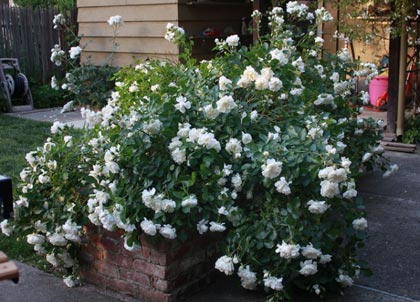
A white groundcover rose refreshes the yard. A flower bed of such a rose would look great at the gate, at the entrance to the house, or even in the middle of the courtyard
Option # 5 - a bright rose garden
Well, what a lover of roses without a rose garden? A flower bed of roses - the best element of decor for the yard or garden. Here, let your imagination run wild and plant the brightest and most unique varieties of ground cover roses. Good looking flower beds from round roses, corner flower beds and ridges. You can colorfully decorate with the stunted roses the foreground of a flower bed with a regular rose. The rosaries look best in central areas of the garden, near the water, or in front of the entrance.

Rosary from white undersized roses looks stylish around brick fences and borders
Many growers sincerely consider ground cover roses the main decoration of their garden. And you can agree with them without hesitation. The rose is a noble, beautiful and desirable flower. Combine your stunted roses with lavender flowers, poppies, asters, irises, phloxes and other crops. With the help of a ground cover rose, you can create a fabulous site design and fill it with a unique scent. Plant roses and they will take root forever not only in the flower garden, but also in your heart.
Ground-cover roses are distinguished by the fact that they spread along the ground and are slightly curved in an arc. Flowers are often collected in inflorescences - semi-double, simple or terry. The diameter of the flowers reaches 1.5-9.0 centimeters. Shoots in length range from half a meter to 2 meters. Coloring petals:
- orange;
- white;
- red;
- yellow;
- pink
The bush is able to cover an area of 3 square meters.
Features of roses in the description and in the photo
- Once planted, the plants grow to the side, not in height, it is clearly seen in the photo.
- Frost resistance - some varieties are not afraid of the cold and do not need shelter.
- All varieties differ in abundant flowering, on one bush can form up to 500 flowers.
- The smell is almost imperceptible.
- Winter-hardy and other species are not afraid of diseases such as: powdery mildew and black spot.
- Flowering roses have shoots covered with shiny and small foliage.
Varieties are divided by height into several types:
- Large - above the meter, shoots arc-shaped, drooping (Fiona). Caring for them is easy.
- Low - from 50 to 95 centimeters, drooping roses, grow slowly, hard shoots, (RedBlanket, IceMeillandecor).
- Widely growing - reaching up, (DagmarHastrup).
- Low - up to 50 centimeters, creep horizontally, grow quickly (SnowCarpet, Avon).
Names of winter-hardy and blooming varieties in summer
Snowballet (New Zealand)
The plant has a light aroma. Flowers terry, color white (have 17-25 petals). Bush loose. Wanted props. Flowering is continuous, which makes it possible to create an excellent design on the site. For the winter you need shelter lutrasil 60 (2 layers).
Merry Maker (Germany)
Without aroma. The color of flowers - apricot, inflorescences of medium size, look good on the photo. It blooms almost all the time. The size is large - up to 6 cm. “Freckles” may appear from the rains. Thorns are small. Plant height - up to 50 cm. Wintering goes under 2 layers of a spunbond 60. Care is simple.
Lovely Fairy (UK)
Flowers reach 4 centimeters. Color - hot pink. Garden design with these plants is gentle. Flowers terry. The width of the plant size reaches 1 meter. In height the bush reaches 50 centimeters. Flowering goes from July to frost. The plant treats a hairstyle well. Care is simple. Rose is not afraid of rain and practically does not get sick. The plant is not affected by powdery mildew, black spot. Frost-resistant flower. The garden goes well with cereals.
Gärtnerfreude (Germany)
Without aroma. The color of flowers - crimson-red, look original in the photo. The leaves are dark green, glossy. In height reaches 50 centimeters. The care is very simple.
Swany (France)
Rose has a light scent. Flowers are white. The width of the bush - from 80 to 200 centimeters. In height the plant reaches from 40 to 75 centimeters. In the garden, the rose blooms profusely.
Lovely Meilland (France)
Fragrance is absent. The flowers are cupped, the sizes are medium, the color is light pink. The leaves are slightly shiny. In height the bush reaches up to 80 centimeters. Blossom is plentiful, but the reaction is bad on rain.
Unicef-Rose (Germany)
Fragrance is absent. The color of flowers is salmon-pink. The width of the bush reaches from 70 to 140 centimeters. In height the plant reaches from 80 to 120 centimeters. Groundcover roses of the presented type are reliable and inflexible. For small areas, the rose does not fit. Brushes bloom with a certain frequency. Over time, a continuous carpet is formed on the site. Flowering goes throughout the summer.
Breeding features
Ground Roses breed in several ways.
Layering
The most common reproduction of layering. It is carried out in early spring. From a long whip it turns out several plants at once, which is good if your goal is to create a site design.
- Choose a long one-year escape.
- Find a place on the ground where you can bend down the escape.
Root offspring
- Dig a groove in the ground. Its depth should be 10 centimeters.
- Conditionally divide the escape into several parts. In each part there should be 1 kidney (for roots) and a pair of buds for the development of shoots.
Varieties of ground cover roses (video)
- Perform an annular incision on the bark under the root bud and pin an escape into the groove so that the incision is located at the bottom.
- Lift the stem up above the ground, pin the next kidney so that the pinned stem looks like the letter W.
- Extremely 2 buds must remain free above the ground.
- The groove should be sprinkled with fertilizer.
- In the autumn, reproduction of groundcover roses should be continued - separate the rooted parts and plant on the beds for growing.
- Save entrenched parts can be in the wet sand in the basement. In the spring they are planted in the garden. But on permanent place cuttings can be planted only a year later.
In the garden should be placed only those roses that fit your site and look good in the photo. Find out in advance what the size of the plant will be and how fast it will grow.
Planting and care
Growing conditions
Ground cover varieties are not only roses with a height of 15 to 20 cm. They can reach up to 2 meters, which does not hurt you to create an excellent site design. From English, many names are translated as floral, magical and everything in this vein, for example, fairy - fairy. In the garden, plants can form not only carpets, but also real waterfalls and cascades.
Summer is different in different regions. It is also necessary to take into account when choosing varieties. Plant shoots will not cope with weeds on their own, and interspersed with them not only look bad on the photo, but also feel bad. You will have to do the weeding yourself.
Landing goes to a prepared place. From the ground should choose the roots of perennial weeds. The pristvolny circles of bushes mulch or cover with non-woven material of black color.
Landing
Landing is subject to certain rules. It is necessary to choose the right place, prepare the soil, apply fertilizer. Care is to pre-digging the soil and removing weeds and their roots. All varieties of roses, if you mumble the soil correctly, will grow and in a couple of years will triumph over the weeds.
Care
Care is almost the same as for other roses. However, watering will require 10-15 liters for each bush. Watering is done in the morning, the water should be warm. If the planting was done recently, young plants are watered frequently. Adult roses are watered at least once a week. Summer can be dry, and under-watering will lead to the fact that the leaves will be the usual color, but the flowers will be small. In the autumn watering should be reduced.
Use cases in landscape design
Planting roses is often used in landscape design. Varieties differ in shape and color, which means that they can be applied in any part of the garden. White and other rose colors are great for any style. Summer in Europe in an elite garden is difficult to imagine without the presented plant.
Planting groundcover roses is widespread, as the flowers are unpretentious in the care and cold-resistant. The care is very simple - pruning is not required, flowering abundant. Species variety of roses is extensive.
The design can be decorated with 5 groups of varieties:
- low with shoots;
- low branching;
- low creeping;
- wide upright;
- wide, with whip-like shoots.
Care for any kind of simple. All roses with hanging branches look great in the flowerpots. The design of the hedge and pergolas is also difficult to imagine without the queen of the garden. Weaving plants are often used as tapeworms. Roses help not only to make the design spectacular, but also strengthen the top layer of soil and protect gentle slopes from leaching. Planting plants along the tracks makes it possible to create a bright border. Next to the roses look great flowers whose names you know well - delphinium and daylily.
Ground Cover Roses in Landscape Design (video)
Of ground cover plants You can create an original garden. All roses are distinguished by unpretentious care and look very attractive.

